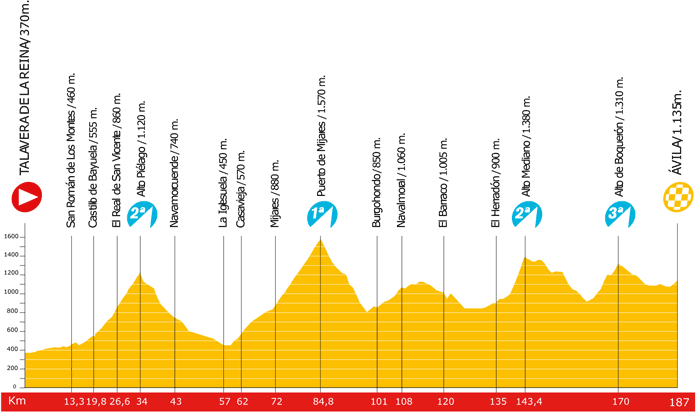Another great day for the breakaway.


The first third of the stage is pretty easy, then the hardest climb of the day, Alto de la Centenera, starts.
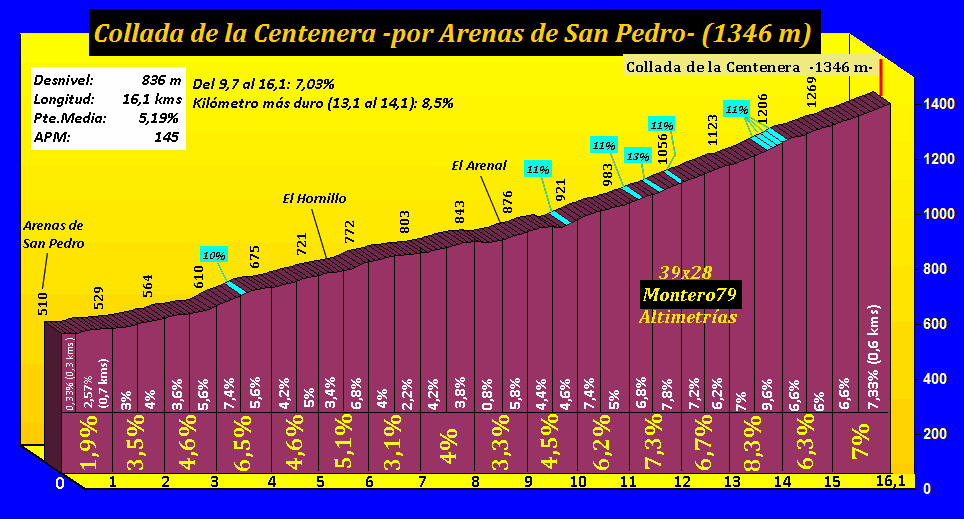
None of the descents (or the climbs, for that matter) on this stage are particularly difficult, but at least this one links pretty well to the next climb, Puerto de Pedro Bernardo, a tempogrinder.
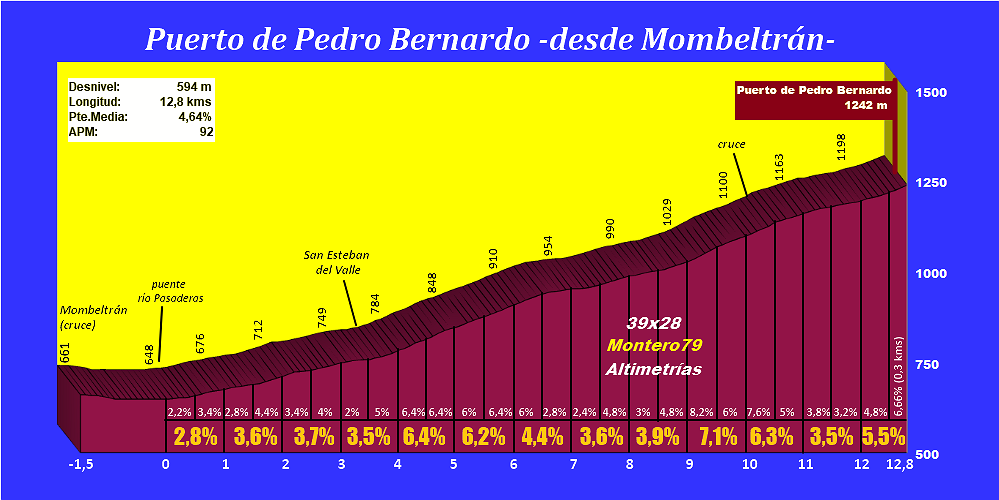
There's some respite after the descent, before the longest climb of the day, Puerto de Mijares, starts. It's very similar to its predecessor in nature, but quite a bit longer.

The descent gives way to a downhill false flat, passing through the intermediate sprint at Burgohondo, before the final climb of the day, the easy Puerto San Juan de la Nava, starts.
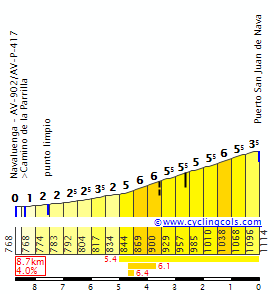
From here, there are 5.4 rolling kilometres to go.
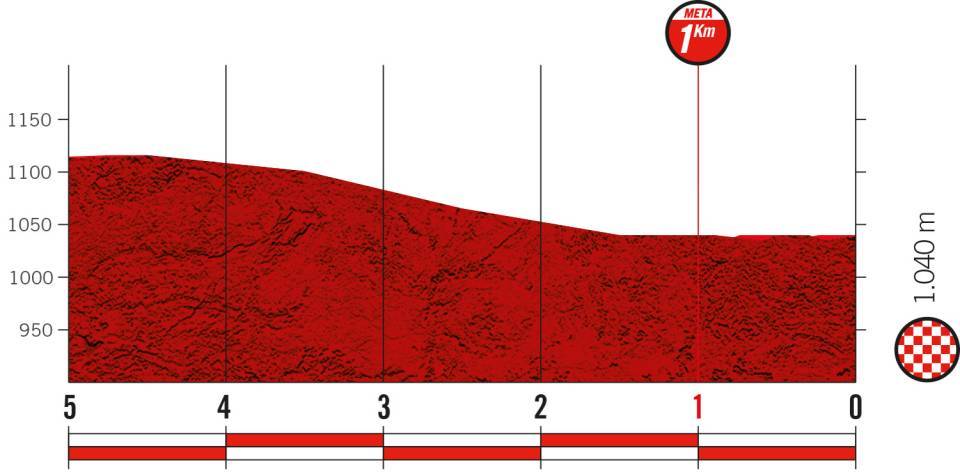
El Barraco is of course a cycling hotbed, being the home of a winner and a runner-up of the Tour de France in Carlos Sastre and Ángel Arroyo, but the finish location honours its third and perhaps most beloved famous son: the late José María Jiménez. The line is on the street named after Chava, in front of the small monument commemmorating him. I have no way of so much as rivalling Libertine's tributes to the town and its cyclists, so I've quoted them below.
The first third of the stage is pretty easy, then the hardest climb of the day, Alto de la Centenera, starts.

None of the descents (or the climbs, for that matter) on this stage are particularly difficult, but at least this one links pretty well to the next climb, Puerto de Pedro Bernardo, a tempogrinder.

There's some respite after the descent, before the longest climb of the day, Puerto de Mijares, starts. It's very similar to its predecessor in nature, but quite a bit longer.

The descent gives way to a downhill false flat, passing through the intermediate sprint at Burgohondo, before the final climb of the day, the easy Puerto San Juan de la Nava, starts.

From here, there are 5.4 rolling kilometres to go.
El Barraco is of course a cycling hotbed, being the home of a winner and a runner-up of the Tour de France in Carlos Sastre and Ángel Arroyo, but the finish location honours its third and perhaps most beloved famous son: the late José María Jiménez. The line is on the street named after Chava, in front of the small monument commemmorating him. I have no way of so much as rivalling Libertine's tributes to the town and its cyclists, so I've quoted them below.
In terms of racing style, Chava was cut from the same never-say-die cloth as Marco [Pantani] and Frank [Vandenbroucke]; searing through the 90s with a racing agenda based primarily on aggressive climbing and paying no heed to subsequent days' consequences. As a result, he was capable of the most imposing, destructive mountaintop victories... and also losing all of the time gained in seemingly innocuous places. There was also another thing that held Jiménez back from accruing a stronger palmarès: he was one of the true pure climbers. Tall but wispy, he would float up the steepest of slopes, but his chrono was diabolical. As an example, he lost thirteen minutes in the two long time trials in the 1999 Vuelta, and finished at +9'24" in 5th. Although it was not his best race, much like Frank Vandenbroucke it is something in that 1999 Vuelta that he is most well-known for. VDB may have won Liège-Bastogne-Liège, Omloop, Gent-Wevelgem and Paris-Nice, but the moment most often brought up in his veneration is the amazing Ávila stage where he towed and destroyed some pretty big name climbers in an intermediate stage. Likewise, Chava's 1999 Vuelta is far from his crowning moment, however that year he wrote himself into Vuelta legend once and for all, when in some pretty horrible weather (but nothing on 2002) he became the first man to triumph on the brutal slopes of the Angliru, which you can relive here as he chases down and defeats the escape of Pavel Tonkov at the last minute. Try to remember in watching that, the climb was brand new at that point, and the Giro hadn't unveiled Zoncolan or Finestre... this only had the Mortirolo to compare to.
Jiménez had been a good prospect, winning the Circuito Montañés in 1992 and with two wins in the difficult mountain Classic the Subida a Urkiola, paired with San Sebastián and finishing on one of País Vasco's nastiest and most heralded climbs (known as the Grand Cathedral of Basque cycling) in the mid-90s, he was developing a name as a mountain specialist. After working his tail off as a domestique for Miguel Indurain, he was allowed a bit of development time of his own. Coming 12th in the 1996 Vuelta, he stepped to the forefront towards the end of the 90s. He made the top 10 of the 1997 Tour de France, albeit over half an hour back from the unstoppable '97-vintage Ulle (the same man he'd be within 10 minutes of despite 13 mins of time trial losses two years later), in service of Olano, and then gave birth to the Chava of legend with a blistering late attack to win a tough stage into Los Ángeles de San Rafaél over Navacerrada and the Alto del León in the King of the Mountains jersey; although had he not led the competition, he would have been able to do it in the national champion's jersey he had won a few months earlier on a hilly course in Melilla (thus proving that Abarcá making sucky national champion's jerseys is nothing new...).
1998 was Jiménez's year. Winning a key mountain stage in the Vuelta a Asturias marked his form out, and winning atop Mont Ventoux in the Dauphiné showed he was a force to be reckoned with in the mountains, and though he entered the race as a nominal superdomestique for Abraham Olano, his blistering climbing form led to a splintering of the team; Chava would deadweight others' attacks and take the lead on two occasions, the second from his team leader with just a couple of stages remaining (though he - of course - lost out massively in the ensuing time trial). He took four stage wins, all key mountains. First was Xorret del Catí - another of those super-steep brutes - then came back to back wins in Vallnord Sector Pal and Cerler, before winning the only time the Vuelta has ever finished at Lagunas de Neila.
The strong field in the 1999 race and some issues with form pacing meant Chava was less potent, only taking the one stage win, though consistent top 5 positions on all mountain stages meant he scored his third straight GPM. 2000 was a less successful year, though he continued his quest to become the undisputed king of Andorra, taking the final two stages of the Volta a Catalunya on mountaintops in the country (Els Cortals and La Rabassa) to take the overall GC, adding to prior wins in Pal ('98 Vuelta) and won the Classique des Alpes. Some strong performances in the Tour were tempered by some abysmal stages, and he left the Vuelta early. In 2001, the mythical climber was back, winning another GPM at the Vuelta along with three stages - once more all mountaintops, two of which were in Andorra (Vallnord Sector Pal once more, and the MTT to Arcalis), and also the steep closing climb of Alto Cruz de la Demanda in La Rioja. It was his last stage win of his career, and secured the mountains classification once more, a fitting way for him to sign off.
And then, he was gone. Jiménez had always had problems with depression, and later in his career these became more and more pronounced. He retired from cycling early in 2002, and got married, but his life without cycling was no less troubled than his life with it; if anything, the time away from the bike exacerbated things. It is widely accepted that he rather fell into the wrong circles; heavy drinking and drug intake paid its price, as with the other stars of the era taken young. Chava lived out his final days in a psychiatric hospital, before succumbing to a heart attack at the age of 32. One of cycling's last tragedies, and one of the last true mythical climbers, had crested the final summit.
[...]
Rest in peace, Chava. The cycling world needs people like you.
I have talked before about the mighty cycling town of El Barraco, or the Spanish answer to Palù di Giovo. This town's population is only around 2.000, however its legacy in cycling is great. It is the base of the Fundación Provincial Deportiva Victor Sastre, a major development club for cycling (the name should be familiar to all of you of course) and home to an interconnected group of great climbers in the history of the sport. In fact, on Spanish wikipedia, in the "Personajes Ilustres" section, there are four people, all connected to ciclismo - Victor and three of the town's legendary riders.
The first of the Hijos de El Barraco to make it as a pro was the great 80s climber Ángel Arroyo, who turned pro in 1979 and rode his whole career in Spain, either with Zor or Reynolds (the forerunners of today's Movistar of course). Winning the Vuelta a los Valles Mineros in his first season, he was taken to the Vuelta in 1980 where he excelled himself as a domestique for race winner Faustino Rúperez, as well as winning the Vuelta a Castilla y León and the Clásica los Puertos. Racing the Vuelta for his own goals in 1981, he took the stage to Los Ángeles de San Rafaél on a punchy climb after the legendary Puerto del León, and finished 6th overall. 1982 is probably what Ángel is best known for, however, after he jumped ship to the young Reynolds team. Escaping with a handful of other major contenders on the Puerto del Escudo early in the Vuelta, he was able to use these gains to manoeuvre himself into the lead in the Pyrenees, before backing up his lead with a victory in the time trial at the start of week 3. After the final mountain stage to Navacerrada, where Arroyo successfully defended his GC lead, however, Ángel was one of four riders - along with Alberto Fernández, Vicente Belda and Pedro Muñoz - who were tested after the race and tested positive for Methylphenidate (more commonly known by its trade name Ritalin). The fifth finisher was Marino Lejarreta, who was not tested as testers only took in the first four; so a few weeks after Arroyo paraded around Madrid in the leader's jersey to celebrate his greatest victory, he became the subject of the Vuelta's biggest scandal; he was assessed a time penalty (it was pretty early in the days of working out how to punish doping!) and the Vuelta fell from his hands and into those of Lejarreta. Depending on your stance on Heras' 2005 reinstatement, Ángel Arroyo may still be the only man to lose the Vuelta in this fashion; Marino Lejarreta never even wore the leader's jersey until taking the lead of the race the following year, unparalleled until Scarponi wore the maglia rosa to the 2012 prologue.
Arroyo's career wasn't derailed by the scandal, however, and the following year he achieved his best (acknowledged) result in a GT when he was 2nd in the 1983 Tour de France, taking his biggest career win when he was fastest in the Puy-de-Dôme MTT and took the first Spanish stage win in the Tour for five years; he took another Tour stage the following year, to Morzine, but could only finish 6th overall, some 15 minutes further behind Fignon than he had been in the previous race. Increasingly usurped at Reynolds by Pedro Delgado, both riders moved on for 1985, with Arroyo returning to Zor, although after a season hampered by physical problems he found himself returning to the fold at Abarcá the following season. However, he never scaled the same heights again, and retired quietly in 1989 after eleven seasons as a pro.

A couple of years after Ángel Arroyo rode off into the sunset, of course, the next man in line to capture the nation's imagination from El Barraco appeared on the scene - the great mythical climber José María Jiménez. I have had plenty to say about Chava over the years at these boards, plenty of contributing to the mythmaking around the glorious escalador that he was as well. There's little need to elaborate on his story at this point, after all I already eulogised him with his own memorial race in this thread and having included a great many sites from Chava's greatest triumphs in my Vuelta routes - Cerler, Arcalis, Cruz de la Demanda, Lagunas de Neila, Xorret del Catí, Angliru, and of course the short punchy ramp into Los Ángeles de San Rafaél where in 1997, just like his hometown colleague Arroyo sixteen years earlier, he took his first Vuelta stage; my fandom for Jiménez was already long established by the time I took him with pick 31 in the Fantasy Doping Draft. He was a man of his time in many ways, but amid the legend-making around Pantani and to a lesser extent Vandenbroucke, he sometimes gets lost in the shuffle a little. After all, the Giro seems to have an almost annual moment of Pantani veneration. Since (I'm still frustrated I couldn't figure out a way to get Priego into the route to honour Ocaña) this route has paid tribute to many past Spanish cycling heroes - Tarzán Sáez, Alberto Fernández, Óscar Freire, the Trueba brothers, the Rodríguez Barros family, Álvaro Pino, José Manuel Fuente, Óscar Pereiro, Lale Cubino and Roberto Heras - I couldn't not include Chava, now, could I?

Also, although born in Liéganes in the Comunidad de Madrid, given the prominence of the family due to the Fundación Victor Sastre, and his closeness to Chava (he was his brother in law), the town also celebrates 2008 Tour winner Carlos Sastre as one of their own, another great climber and the poster-boy for "riding your own tempo," every bit the smart and sensible racer that was the perfect counterpart to Chava's heart-over-head style.
Last edited:



